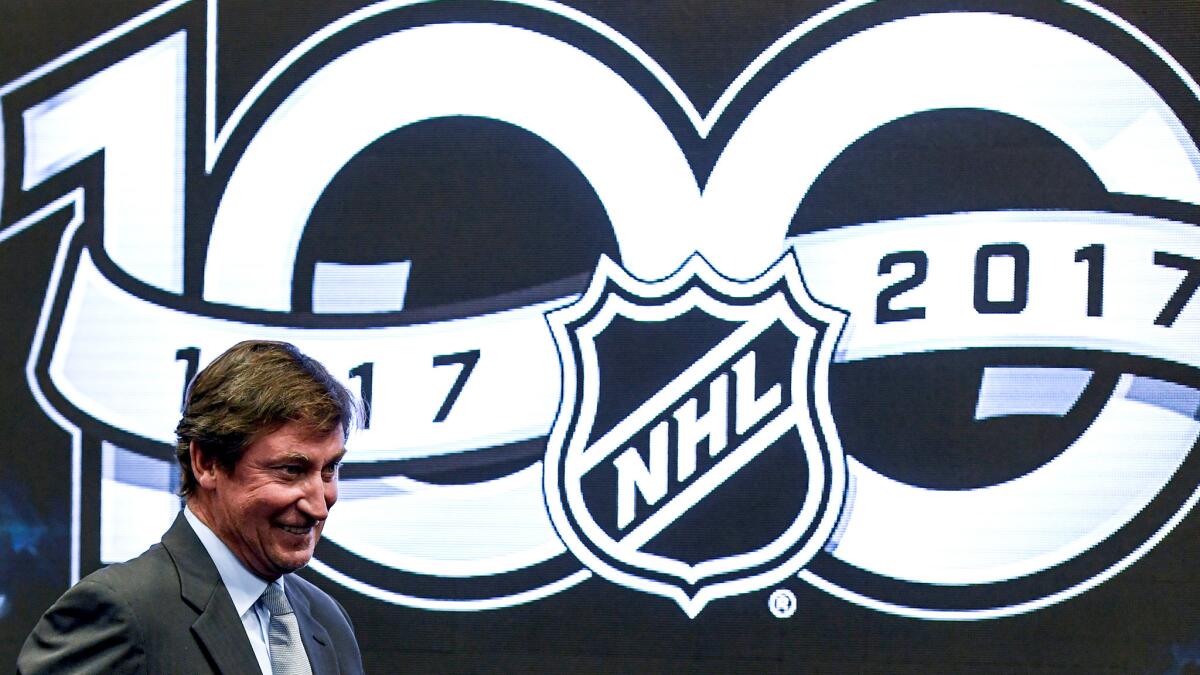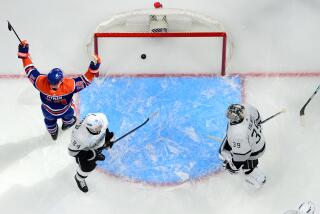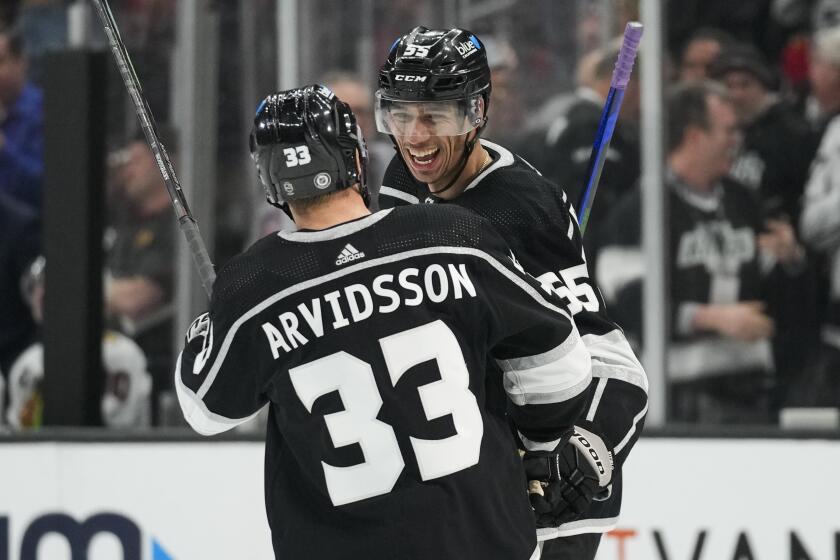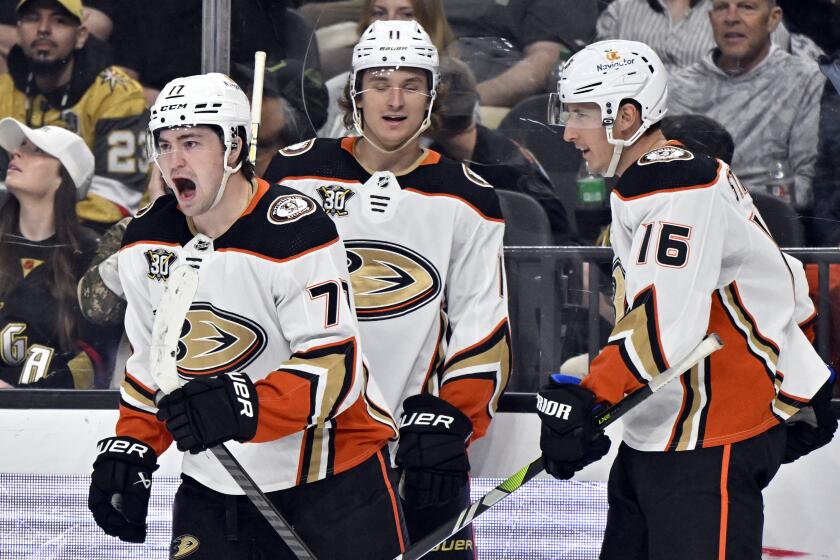Column: A fine skate of affairs for NHL’s 100th anniversary

Let’s enjoy this peaceful time in the National Hockey League, this happy interlude between lockouts, the last great days of the Original 30 Era before the first puck is dropped to welcome the still-to-be-named Las Vegas franchise.
When the season begins Wednesday, the NHL will celebrate the 100th anniversary of its founding and the 50th anniversary of its first major expansion, which doubled the league’s size from six teams to 12 for the 1967-68 campaign. The men who gathered at a Montreal hotel in November, 1917 to form the NHL from the ashes of the National Hockey Assn. couldn’t have envisioned what the league looks like now, with teams based in California, Florida and Texas and another to launch in Las Vegas for the 2017-18 season.
“At nearly 100 we have never been stronger, better, younger and never been faster and have never had a brighter, more diverse future,” Commissioner Gary Bettman said during the World Cup of Hockey, a rare instance of cooperation between the league and the NHL Players’ Assn. on an event staged to generate new revenues and promote the game internationally.
“The constant, through the decades of good times and bad, through eras of peace and prosperity, in periods of conflict and hardship, through all the generations since 1917, is that the great game of hockey — NHL hockey — has grown and strengthened and represents a truly global presence.”
Reviews on the World Cup were mixed. A lack of competitive balance and the early exit of Team USA contributed to low TV ratings in the United States despite ESPN’s return to televising hockey, but TV ratings were strong in Canada even if Toronto’s Air Canada Centre was never filled or buzzing. The contrived Team North America, stocked with players 23 years old and younger from Canada and the U.S., became an unexpected attraction because of its breathtaking speed and skill. We could dream, if only briefly, about seeing that kind of creativity in the NHL if coaches gave players free rein and didn’t mold them into defense-first machines.
In addition, Team Europe — a mix of players who had represented eight nations — reminded everyone about the value of team bonding while becoming a surprise finalist and giving Canada a reasonable challenge in the finals.
But for the Kings, who lost winger Marian Gaborik to a broken foot, and the Dallas Stars, who lost forward Tyler Seguin to a fractured heel, sending players to a 2020 World Cup and other possible international events might not seem like a great idea. Whether NHL players will participate in the 2018 Winter Olympics in Pyeongchang, South Korea is expected to be settled by the end of the calendar year in negotiations involving executives of the NHL, NHLPA, International Olympic Committee, and the International Ice Hockey Federation.
Players want to go but the league is balking at the IOC’s refusal to continue paying costs of about $15 million for transportation, insurance and accommodations of NHL personnel. And many owners still don’t like shutting down for two weeks during the middle of the season in order for players to represent their homelands in the Olympics when the NHL gets no money from that.
But those issues are separate from the upcoming season, one which features relative stability for the NHL’s business operations (aside from the fall of the Canadian dollar) and the assurance of labor peace through the 2019-20 season. While it’s logical for the NHL to look beyond its geographic borders for new revenues and audiences, it’s imperative that it addresses a number of nagging issues at home.
The most prominent of those issues is the stagnation of scoring, which has remained low despite the introduction of rule changes and tweaks intended to boost goal production. Teams combined last season to score an average of 5.337 goals per game, down from 6.051 in the 2005-06 season (The numbers exclude shootout goals.). A plan to streamline goaltenders’ equipment by limiting the dimensions of their pants and chest protectors this season had to be delayed because manufacturers were late in delivering prototypes to be tested, but those changes alone, when implemented, probably won’t make much difference.
Goalies, once the worst athletes on their teams, are now among the best, and there’s no rolling back the years of specialized coaching they’ve received and still get. Playing on the wider, international-size ice isn’t the answer, either. Because there’s not enough scoring talent to go around, it’s easier for coaches to try to neutralize opponents’ skilled players than to ask their own players to raise their games.
There are no easy answers, but maybe the recent league-wide trend toward speed over muscle will continue and will lead to more scoring. Pittsburgh, San Jose, Tampa Bay and others thrived by emphasizing speed, and it’s likely that other teams will try to copy that formula as much as they can.
The promise of seeing more speed is among the reasons to look forward to the new season. There will be four outdoor games, the Detroit Red Wings will bid farewell to Joe Louis Arena — which will be replaced by Little Caesars Arena — the Edmonton Oilers will inaugurate gleaming, new Rogers Place, and the league will celebrate its centennial season with events that evoke the past while its teams introduce the stars of the future.
We will miss Vincent Lecavalier, who retired, and Pavel Datsyuk, who returned to Russia, but kids such as Toronto’s Auston Matthews, Edmonton’s Connor McDavid, Winnipeg’s Patrik Laine and Calgary’s Matthew Tkachuk, among others, will continue the annual replenishment of talent that sustains the NHL, flawed though it may be.
Twitter: @helenenothelen
More to Read
Go beyond the scoreboard
Get the latest on L.A.'s teams in the daily Sports Report newsletter.
You may occasionally receive promotional content from the Los Angeles Times.







